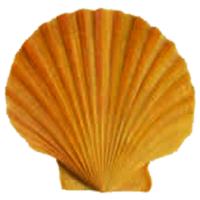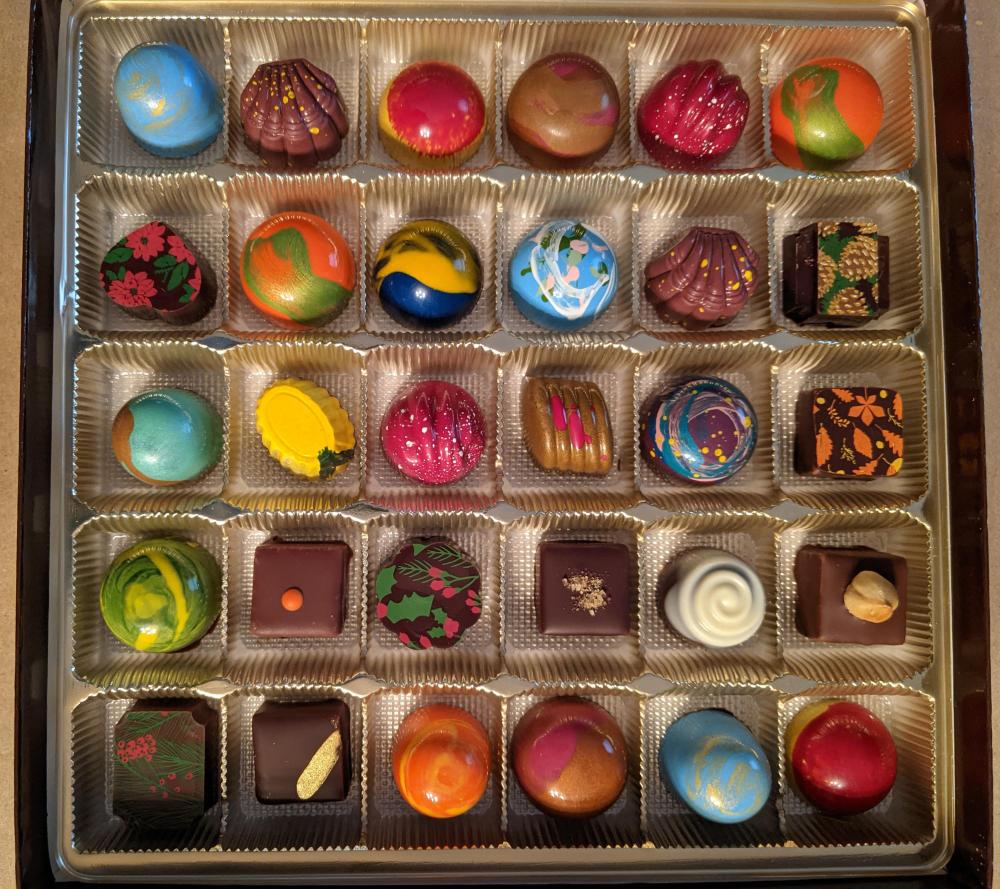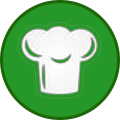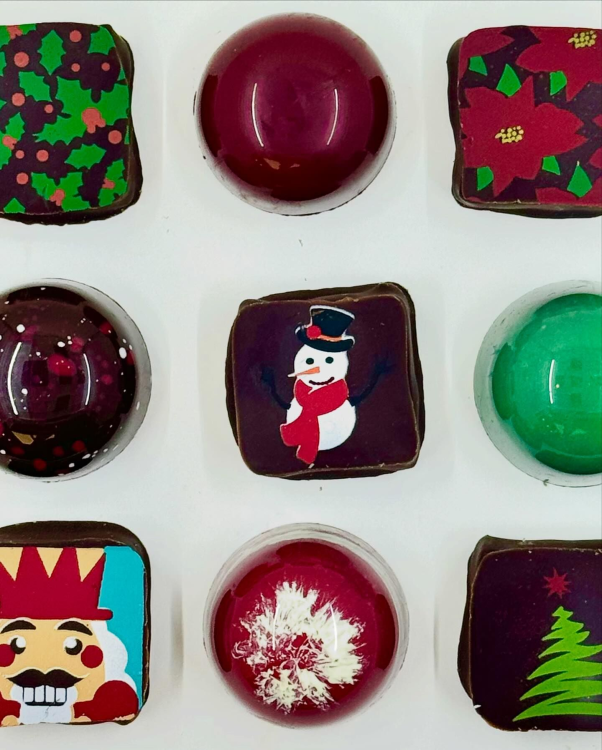-
Posts
2,412 -
Joined
-
Last visited
Content Type
Profiles
Forums
Store
Help Articles
Everything posted by Jim D.
-
The first time I made this ganache, I followed the recipe exactly, and the mint flavor was almost undetectable (you may recall from my previous post that the ganache also includes lemon, a difficult flavor to compete with). The following times I have included perhaps four times as much mint. Another difference is that the recipe calls for white chocolate--not what you are looking for. I think you really need extract (so you are out of the reach of Amazon? I think Jeff Bezos needs to be informed of this gap in the company's coverage), so I would recommend @Alex's suggestion. Another problem with fresh mint is that it can develop an off-taste (think damp lettuce that has been sitting around too long).
-
Having made a bonbon with fresh mint (plus lemon)--it's a Peter Greweling recipe--I can attest that fresh mint is very muted (and that's putting it nicely). And Greweling's recipe calls for leaving the chopped leaves in the ganache! The result barely resembles what people think of when they think "mint chocolate." It would take a lot of fresh mint to give adequate flavor. Do you have the same objection to mint oil? Both extract and oil come in "natural" form.
-
Your Dubai fillings looks terrific. I'm not asking for your recipe, but do you mind describing how you made the filling?
-
Love the Ruby color, and the filling sounds perfect for a chocolate that's difficult to match with not-too-sweet fillings. I see that you have your branded boxes. The business is off and running.
-
The filling sounds delicious. I imagine the lime helps balance the coconut's sweetness.
-
Thanks for pointing out that pistachio paste available on Amazon. I just noticed that my source, L'Epicérie, has it only on special order (I guess the price scared customers off--though it is a bit lower than the item on Amazon). I also make Dubai bonbons, although (as I have stated elsewhere) filling the cavities is a real pain--I put foil over all the cavities except the row I'm working on so as to limit the mess. But I don't want to reduce the crunch, which is what it would take to get the filling out of a pastry bag or (the otherwise indispensable) confectionery funnel.
-
I purchased pistachio butter from Fiddyment Farms. It is simply ground pistachios, no sugar added. I put it in my melanger and added some ground up hard caramel to make pistachio praline paste, which (I think) adds a lot of flavor to the pistachios. But to cut the sweetness I also include plain pistachio paste from Sicily. I know this all sounds counter-intuitive, but the Siciian paste has a wonderful flavor, and I do want the caramelization taste as well. And yes, I add white chocolate, making a gianduja. If you add any water (making a ganache), the general principle is that anything crunchy will (eventually) get soft. And since the whole point of the Dubai bar is crunchiness, I want to preserve the texture of the kataifi (for more crunchiness I also add some crushed feuilletine, plus some chopped pistachios). I don't add a lot of chocolate because I want to preserve the fluid texture that the Dubai bar seems to have.
-
Good idea about reducing the sweetness. I use pistachio praline paste plus plain pistachio paste (no sugar) to reach that goal.
-
@RWood, I'm interested in your comment about tahini improving the Dubai bar. I followed a recipe that included tahini (most recipes do, I think), and I did not detect any sesame-y taste added to the filling. The next time I omitted the tahini paste and tasted no difference. What do you think it added? I've never thought that tahini had a lot of taste on its own; in my "sesame crunch" bonbon I add lots of toasted sesame seeds, which do give it some flavor. The tahini paste I use is from Soom, and the seeds used are toasted.
-
I know this is a very old post, but I do know @JeanneCake is still alive and kicking, so I'll ask: I make Rose's biscuit for the bûche cake. After I turn it upside down onto a towel (I know you don't use one, but often I've had the cake crack horribly when I rolled it) and then remove the parchment (now on top of the upside down cake), the parchment sticks to the cake, removing the best-tasting part, the outer browned part. Would using the spray prevent that? And do you mean something like Pam?
-
Christmas 2024 assortment: 24 different fillings, including crème brûlée, sesame crunch, apple crisp, pecan pie, cinnamon bun, tiramisù, pineapple caramel, orange with habanero chili, carrot cake, and baklava. Credit must be given to @Rajala for the ideas behind some of the bonbons: the crunchy layer of crème brûlée (which I have now figured out to make even on a humid day), carrot cake (my new fave), and cinnamon bun. I especially want to thank him for his clever idea of how to make a ganache that tastes like custard and thus makes a crème brûlée very close to the baked custard of that dessert.
-
@Kerry Beal is the gingerbread cookie ganache the one in Greweling's book? He enrobes it and drops a little turbinado sugar on top. I am always amazed at how close to gingerbread it tastes; the "secret" ingredient is anise liqueur (I use Sambuca).
-

Your Daily Sweets: What Are You Making and Baking? (2017 – )
Jim D. replied to a topic in Pastry & Baking
@Pete Fred I always enjoy your experiments (usually successful I have noted) into the world of sweets. I was struck by your recent comment: Do have you any ideas as to why this happens? I tried buttering the pie pan, and that resulted in an unpleasant fried look and taste to the crust. I suspected I might be patting the crust into the pie pan too firmly; changing that technique seemed to help some, but not consistently. -
I do toast the kataifi. Recently I saw someone making a Dubai bar and he "fried" the kataifi. That gives it more flavor. You have to use clarified butter or ghee; otherwise some of the crunchiness will be lost. Basically the Dubai bar is a gianduja.
-
I have done Dubai bonbons. It's very tricky to spoon the filling into the cavities (It's too chunky for a pastry bag), but it's very popular--alas, the chocolatier has a difficult time not eating all of them. I add some feuilletine to the kataifi and toasted pistachios for even more crunch.
-
I have a Chocovision Delta tempering machine and have recently switched to using silk for tempering. I found it difficult to use tempered chocolate as seed. If I used the callets from the bag, they didn't entirely melt--a real nuisance. To my surprise, I have found that chocolate tempered with silk seems to take longer to get in an overtempered state, and with the Chocovision machines and their constant motion, overtempering is a significant problem. It doesn't take much silk at all.
-
I agree with Kerry; the pieces are enrobed. There are square magnetic molds, but they have sharper edges.
-

Airbrushing cocoa butter on a budget: equipment information
Jim D. replied to a topic in Pastry & Baking
@Becky R, interesting information. Can you provide a link to the Oxo squeegee you use? -

Molded and Filled Chocolates: Troubleshooting and Techniques
Jim D. replied to a topic in Pastry & Baking
You know far more about this stuff than I do, but I have had that "dusty" look with bonbon shells, but on the inside of the shell. My best theory is that the chocolate is over-tempered (it happens after I have been using the chocolate for a while and have not taken steps soon enough to deal with it). In my case, eventually the dusty look doesn't show, and it has never seemed to do any harm. I assume you are doing all the usual things, such as chilling the bars as they are crystallizing. And I assume humidity is not an issue in your kitchen. -
I saw that you particularly like Roxy & Rich's Fuchsia Tourmaline, which appears (to me) to be in the purple category. So far I have not found a purple I really like (Chef Rubber's Purple Amethyst is what I often use, but it doesn't have that pop I'm looking for in a purple--it needs more red, I think). Do you have purple favorites?
-
I have heard good things about Chef Rubber's natural white color (not sure of its exact description). A number of people have stated that the natural colors fade. I think Andrey Dubovik has switched (at least partially) to natural colors, and his creations now look a bit faded. Perhaps we will eventually get used to duller colors and won't remember what existed way back in 2024?
-
With the changes in the U.S. administration coming in 2025 and promises of ridding our foods of unnecessary additives--and artificial colorants!--perhaps those of us in this country need to check out the natural cocoa butter colors available from some manufacturers. Am I actually ready to substitute beet juice for Chef Rubber's "Red Ruby"? And is there a blue vegetable that can replace the beautiful "Blue Lapis"? Hmm.
-

Spraying Chocolate: Equipment, Materials, and Techniques
Jim D. replied to a topic in Pastry & Baking
@Kerry Beal, which airbrush did the chocolatier like best? I used to have many more reservations about the Fuji than I do now. And I hate to abandon my Grex (especially after I spent so much time working with tech support to get it to spray colored cocoa butter successfully). But there is nothing better than the Fuji for getting the job done as quickly as possible--and with far less need for reheating the spray gun. Yes, the Fuji uses more CCB, but with all the suggestions I received from @Chocolot, I got the adjustments of the various knobs right and now use less CCB. I think many spray guns do an excellent job as well and cost far less than the Fuji, but my compressor isn't adequate to support a spray gun. -
pastrygirl beat me to it, but I was going to mention the Felchlin Opus Blanc white chocolate. I have not used it in making bonbons but have tasted it, and it is very milky. @CazG, I'm not sure I fully understand what you are looking for. A basic filling that can be flavored for various bonbons? In the case of something like tiramisu, once you add the coffee flavoring, you are not going to taste much milk/cream or even white chocolate (I use coffee ganache made with a mix of white and dark chocolate plus mascarpone). A couple of other ideas: You can substitute plain cocoa butter for some of the white chocolate and reduce the white chocolate taste (though there is a limit at which the texture of the ganache is ruined). You can use a white chocolate with less taste of its own: Cacao Barry's Zephyr perhaps? But I think Felchlin's Opus Blanc is still your best bet (if you can find it). Another more radical idea is to use a butter ganache: Mix soft butter with some sort of sweetener (glucose or fondant) plus flavoring and chocolate. There isn't any cream, but the butter (depending on the brand) can add a lot of dairy flavor. The Peter Greweling book has lots of recipes for butter ganache. Again, however, the flavoring can end up masking any strong dairy taste.
-
I should add that I recently saw a photo of chocolates from @Chocolot. The transfers are from Chef Rubber, and the reds look good. Maybe I should give CR another chance.






